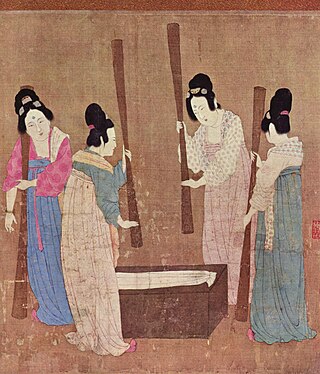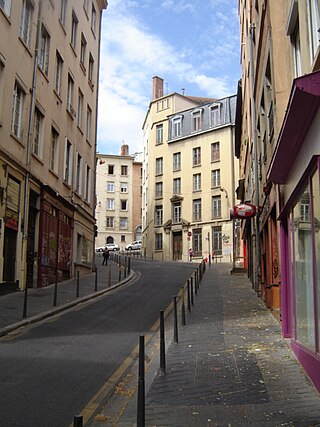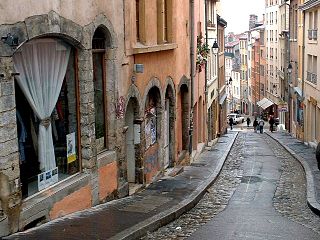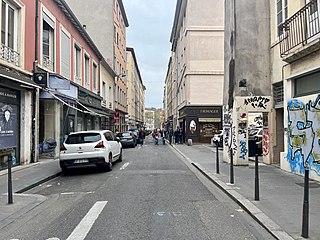
Joseph Marie CharlesditJacquard was a French weaver and merchant. He played an important role in the development of the earliest programmable loom, which in turn played an important role in the development of other programmable machines, such as an early version of digital compiler used by IBM to develop the modern day computer.

The Lyon Metro is a rapid transit system serving Lyon Metropolis, France. First opened in 1974, it currently consists of four lines, serving 42 stations and comprising 34.4 kilometres (21.4 mi) of route. Part of the Transports en Commun Lyonnais (TCL) system of public transport, it is supported by two funiculars and a tramway network.

Traboules are a type of secret covered passageways primarily associated with the city of Lyon, France, but also located in the French cities of Villefranche-sur-Saône, Mâcon, and Saint-Étienne, along with a few in Chambéry. In Lyon, they were originally used by silk manufacturers and other merchants to transport their products.

Lyon is the second-largest city in France by urban area and the third largest by city limits. It is located at the confluence of the rivers Rhône and Saône, to the northwest of the French Alps, 391 km (243 mi) southeast of Paris, 278 km (173 mi) north of Marseille, 113 km (70 mi) southwest of Geneva, Switzerland, 58 km (36 mi) northeast of Saint-Étienne.

The production of silk originated in Neolithic China within the Yangshao culture. Though it would later reach other places in the world, the art of silk production remained confined to China until the Silk Road opened at 114 BC. Even after trade opened, China maintained a virtual monopoly over silk production for another thousand years. The use of silk within China was not confined to clothing alone, and silk was used for a number of applications, such as writing. Within clothing, the color of silk worn also held social importance, and formed an important guide of social class during the Tang dynasty of China.

The Canut revolts is the collective name for the major revolts by Lyonnais silk workers which occurred in 1831, 1834 and 1848. They were among the first well-defined worker uprisings of the period known as the Industrial Revolution.

La Croix-Rousse is a hill 254 metres (833 ft) high in the city of Lyon, France, as well as the name of a neighborhood located on this hill. The neighborhood is divided into les pentes and le plateau. This zone is served by Lyon Metro Line C. With 18th century architecture, including unique dwellings for labourers, La Croix-Rousse was inscribed on the UNESCO World Heritage List in 1998 to protect Lyon's long history as an important European city.

The 4th arrondissement of Lyon is one of the nine arrondissements of the City of Lyon.

The Place Sathonay is a square located in the 1st arrondissement of Lyon, France, at the bottom of hill of La Croix-Rousse, in La Martinière quarter. It was named after Nicolas-Marie-Jean-Claude Fay de Sathonay, mayor of Lyon from 1805 to 1812, as a tribute for all the importants works undertaken under his presidency. The square is currently the third largest square in Lyon and belongs to the zone classified as World Heritage Site by UNESCO. According to Lyon geography agrégé Jean Pelletier, it is "one of the most interesting squares of Lyon", because of its harmonious proportions, its boundaries composed of buildings with beautiful 1920s facades, and its plantations, which brings "a charm tinged of poetry" and give it the appearance of a village square.

The Montée des Carmélites is one of the oldest streets of Lyon, dating from Roman times, located in the 1st arrondissement of Lyon. It connects the Saint-Vincent quarter to the Plateau de la Croix-Rousse. It is situated between the Rue de la Tourette and the Rue Ray Fernand, and ends at the intersection of the Rue Burdeau, Rue du Jardin des Plantes and Rue de l'Annonciade.

The Cour des Voraces, also called Maison de la République, is a courtyard building in the Pentes quarter, in the 1st arrondissement of Lyon, famous for its enormous six-floor stairway. It is an impressive traboule, a covered passage with entrances on the Place Colbert, Montée Saint-Sébastien and Rue Imbert-Colomès.

The Montée de la Grande Côte, or the Montée de la Grande-Côte, is a street of La Croix-Rousse quarter, in the 1st arrondissement of Lyon, which connects the Terreaux quarter and the Plateau de la Croix Rousse. It is characterized by a high elevation and is more narrow at the bottom. The street belongs to the zone that is classified as World Heritage Site by UNESCO.

The Rue Burdeau is a street located in the 1st arrondissement of Lyon, at the bottom of the slopes of La Croix-Rousse, just above the Église Saint-Polycarpe, between the Saône and the Rhône. It leads at one side to the Montée Saint-Sébastien and at the other to the Jardin des Plantes and crosses the Montée de la Grande Côte which renovation is completed. The street belongs to the zone classified as World Heritage Site by UNESCO.

The Rue d'Austerlitz is a street in the 4th arrondissement of Lyon, in La Croix-Rousse quarter. It begins on the Rue du Mail, at the corner of the Place de la Croix-Rousse, crosses the Rue du Pavilion, the Rue de Belfort and the Rue Aimé Boussange, and ends on the Place Bellevue. Its name refers to the Battle of Austerlitz, one of the greatest victories of Napoleon. There are metro and velo'v stations.

The Rue Dumenge is a street located in the 4th arrondissement of Lyon, in the quarter of La Croix-Rousse. It begins on the Rue du Mail, crosses the Rue du Pavillon and the Rue de Belfort and ends on the Rue Dumont-d'Urville. The street is served by a metro station of the line C and a velo'v station.

The Rue du Sergent Blandan is one of the oldest streets of Lyon. It connects Saint Vincent and the slopes of the Croix-Rousse quarters, in the 1st arrondissement of Lyon. The street starts at the Rue Pareille, runs along the Place Sathonay, crosses the Rue Hippolyte Flandrin, the Rue Louis Vitet and the Rue du Terme, and becomes the Rue des Capucins just after the square of the same name. The street belongs to the zone classified World Heritage Site by UNESCO. It is named in honour of Sergent Blandan, who participated in the conquest of Algeria.
The Society of Catholic Worker Circles is an association created in 1871 by Count Albert de Mun.
The following is a timeline of the history of the city of Lyon, France.

The parc de la Cerisaie is an urban park in the Croix-Rousse 4th arrondissement of Lyon, France. It is partially situated on a slope, leading from the plateau of the Croix-Rousse down towards the river Saône.

The ceintures de Lyon were a series of fortifications built between 1830 and 1890 around the city of Lyon, France, to protect the city from foreign invasion.



















